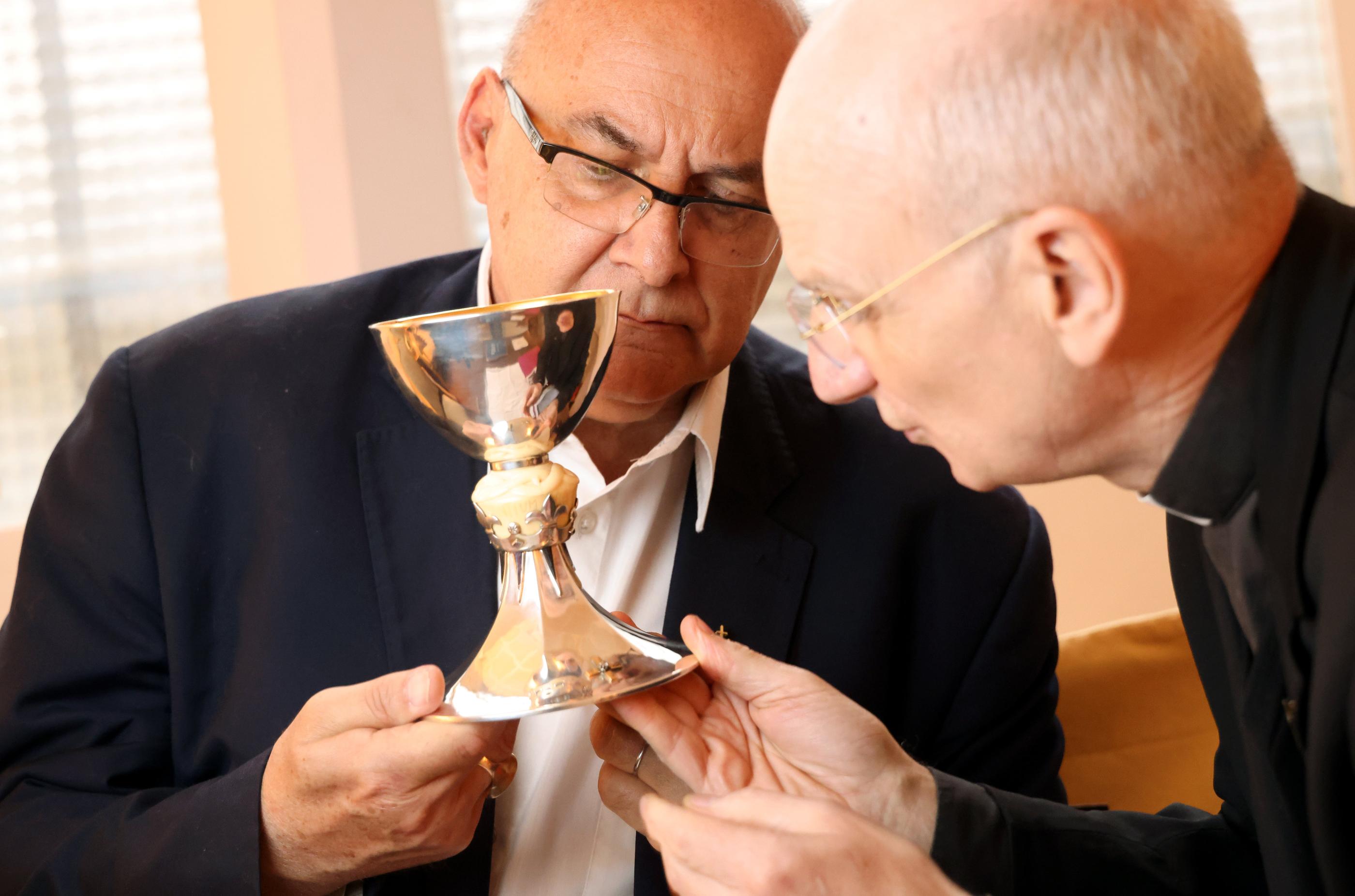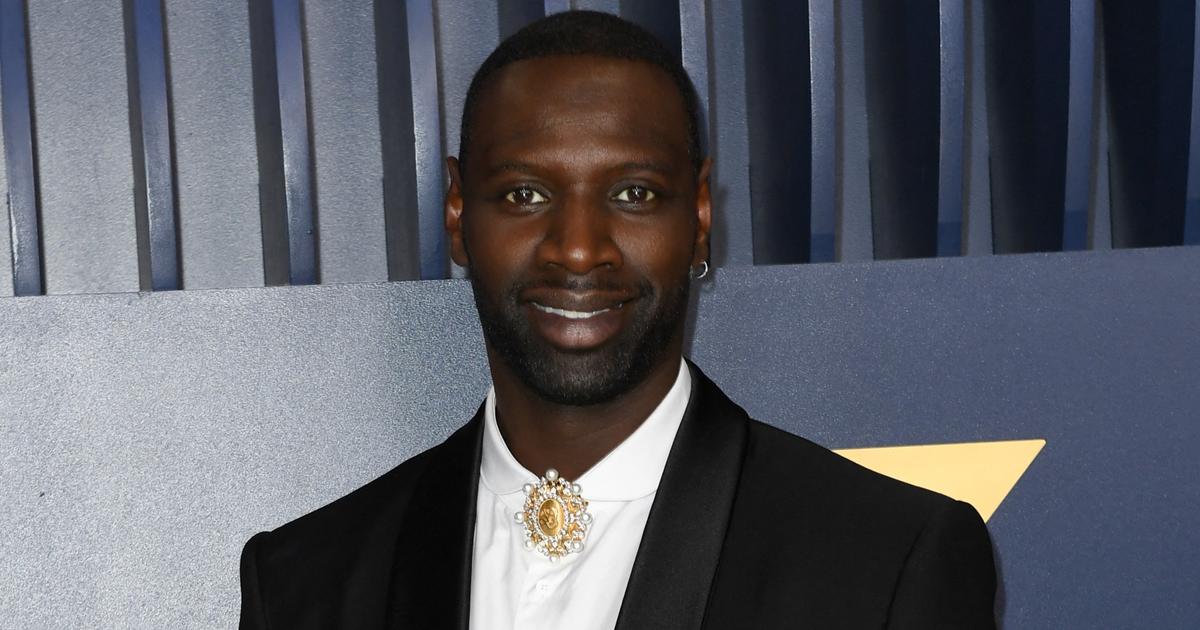An eternal Norman wardrobe stands out at the entrance to the chapel of Accueil Saint-Michel in Paris (11th century), stronghold of the “exorcism service”.
Inside, a bottle of open mass wine, reserves of hosts, a ciborium housing the slices of unleavened bread at the time of communion.
A chalice sits near the purifiers, these white cloths intended to be wiped off after use.
It is silver and gold.
His foot, adorned with a cross with inlaid diamond.
In the center, an ivory ring bearing the effigy of Christ's crown of thorns, here circled with lilies, makes it easy to grab hold of.
“It is the sacred vessel of a martyr. Every time I say mass, I think of him, I made a friend in heaven, ”illuminates Father Jean-Pascal Duloisy, 62 years old. The owner of the place who accompanies the flock under the influence of the devil sees in the fate of this mysterious cup a sign of the Almighty, "the good which outweighs the evil". "She was torn from nothing", greets, for his part, Alain Pignel, fervent Catholic at the head of a monk and "forty-year-old friend" of the chief exorcist. Together, they have just solved a hell of a puzzle. Months of investigations were needed to identify the first owner of this object recovered by chance in Morocco: a resistance fighter with a Roman collar shot by the Nazis.
This saga, which one would think inspired by a detective novel and the film "Indiana Jones", has its source in Marrakech. Alain, a show producer, flies there regularly. At the end of the afternoon of July 2019, he escapes into the souk. Hassan, a second-hand dealer of his acquaintance, beckons him from his shop selling swords and jewelry near the dyers market. " I have something for you ! He frees a chalice wrapped in newspaper from a canvas bag. “I'm not ecstatic, I know it could raise the stakes. It is in its own juice. The bottom was scraped to verify it was gold. I turn it over and there, I see a name, Jacques Leclerc, and a date, October 12, 1941, ”rewinds the young sixty-year-old.
He films his find and immediately sends the video to his demon hunter friend.
"We must bring this chalice home, it must be used for worship, buy it", begged the latter.
The shopkeeper announces the price: 5,000 euros.
Alain "falls backwards" and tries to haggle.
For once, its supplier of nuggets does not "let go".
He returned empty-handed to Paris, but Father Jean-Pascal refused to give up on this treasure intended for the liturgy.
“What we want, we have it!
»He sermons with his funny mimicry à la Louis de Funès.
“It must be used for worship, buy it”: Father Jean-Pascal Duloisy, who officiates in the chapel of Accueil Saint-Michel, did everything to “bring this chalice home”.
Jean-Baptiste Quentin
On December 10 of the same year, Alain reappears in the souk. He withdraws 16,000 dirhams (1,500 euros) in denominations of 100 and then finds Hassan who has still not sold his “exceptional” coin. He puts a bundle of "160 biffetons" before his eyes. “Here, I don't have more! »Deal concluded. Alain hastens to inform Father Jean-Pascal who financed this acquisition with funds from the diocese of Paris, the new owner. “Hallelujah! Exclaims the clergyman over the phone.
A few days later, he deposits the chalice with a goldsmith in the capital for a makeover at 500 euros, making, among other things, "the great shine in the background" disappear.
In the process, the sparkling good of a thousand lights resuscitates during the midnight mass under the circus Grüss marquee celebrated by the Archbishop of Paris, Mgr Michel Aupetit, with Alain in the costume of Mr. Loyal.
Its owner, Jacques Leclerc, ordained priest in 1941
After Christmas, this faithful curious sets out in the footsteps of the so-called "JACQUES LECLERC" engraved in capital letters under the foot of the chalice.
The surname is surmounted by three words in Latin,
Ut Sint Unum
.
A biblical word retained as a motto which was transposed out of order.
Because the exact formula is
Ut Unum Sint
, translate "Let them be one
"
.
Another clue, the inscription "OB-SB".
Alain thinks he has deciphered the abbreviation of “Order of Saint-Benoît”, that of the Benedictines.
The inscriptions under the foot of the chalice allowed Alain Pignel, a devout Catholic who found it in Morocco, to investigate its provenance.
Jean-Baptiste Quentin
He therefore writes to certain monasteries, notably in the Maghreb, which could have met, in the past, a “monk” called Jacques Leclerc.
Without results.
And for good reason: he will later notice that these four letters mean “Oblate of Saint Benedict”, an oblate being a baptized person who, without becoming a monk, “gives himself” to a religious community.
It is also addressed to the archdiocese of Rabat.
In vain.
He shares his research with his neighbor on the 4th floor who, on Google, has the excellent idea of tapping “abbot” Jacques Leclerc rather than “priest”.
And there, miraculously, a site dedicated to those shot in World War II has identified this identity.
It is about a vicar (right arm of the priest) in Dives-sur-Mer, coastal city of Calvados, “born in 1913”, “arrested by the Gestapo” in July 1944, tortured in Pont-l'Évêque then murdered.
Alain joins the archivist of the diocese of Bayeux-Lisieux.
His interlocutor extracts the card of the ordained priest… October 12, 1941. The date inscribed under the chalice.
“When I heard that, I was shaking,” says our faith-doped Sherlock Holmes.
"It is a signature, an irrefutable proof", breathes his friend to the good three decades of priesthood.
English paratroopers hidden in the church tower
Jacques Leclerc, only child, is the son of a designer then an executive of the Railways who died in 1936. He lost his mother three weeks before his ordination. "She died of an embolism at Bayeux station, on the Caen-Cherbourg train", details Nicole Le Pesant, retired passionate about genealogy who has contributed to the building. “The diamond in the chalice is undoubtedly that of her engagement ring,” Alain says. It is closer to the association "A river for freedom, the Dives" which maintains, in Dives-sur-Mer, the memory of the Resistance. He learns that the cleric, who died for France at the age of 31, fell into the clutches of the Nazi occupiers after hiding English paratroopers in the church steeple. "He did not ask himself any questions to save them", admires Christine Le Callonec,president of the association.
Dives-sur-Mer (Calvados), November 1946. Abbé Jacques Leclerc, beaten with a blackjack, executed, thrown into a mass grave with 27 other resistance fighters, will finally have the right to a funeral in the presence of a huge crowd after the war.
Beaten with blackjack, he was then executed. His body was found in November 1946 with that of 27 other resistance fighters in the mass grave of Saint-Pierre-du-Jonquet, about twenty kilometers from Dives-sur-Mer. All were thrown into muddy water from a bomb hole. On him, a small cross, a handkerchief with his initials and a breviary. He is entitled to a funeral in the presence of a huge crowd come to pay homage, in the rain, to the eight Divais exhumed from the mass grave. In 1948, he was elevated, by decree, to the rank of second lieutenant posthumously. Revenge on life: during the mobilization in 1939, the little guy of barely more than 1m60 had been reformed for "irremediable muscular insufficiency" linked to his very frail constitution as indicated in his military booklet.
“When we met the Germans on our outings, he would say to us:
Sing louder than them!
"
The vicar is buried in the cemetery behind his Notre-Dame church.
On his (modest) tomb, a cross-shaped stele, a flowerpot painted in blue-white-red, poet's carnations, anemones and sprigs of lily of the valley.
In the city, only Marcel, 93, a former altar boy, has very precise memories of "Monsieur l'Abbé" alive.
He rubbed shoulders with him every Thursday at patronage.
“We were going for a walk in Cabourg, he made us discover the treasure hunts, silent cinema…” He evokes a “leader with an adventurous spirit”.
“He was going down the Dives coast on skis.
Yes, during the war, the winters were much harsher than now, ”shivers the nonagenarian with the white mustache.
In the city, only Marcel, 93, a former altar boy, has very precise memories of the living abbot.
He evokes a "leader with an adventurous spirit" a little "provocative".
“Monsieur l'Abbé” was also “a little provocative”.
“He had recovered a Nazi soldier's belt and asked a friend of the patronage who did a lot of tinkering to replace the swastika with the scout cross.
But he had left the motto
Gott mit uns
(God with us).
When we met the Germans on our outings, he would say to us:
Sing louder than them!
As a kid, Marcel dreamed of being an aviation mechanic.
"He had asked me:
Wouldn't you rather go to the seminary, could you become a mechanic of souls?"
Finally, I ended up as a turner at the factory.
"
Father Georges Lefebvre, 82, a priest in the town for thirty-two years, has never known his distant predecessor.
But his fate moved him a lot.
“Jesus said:
There is no greater love than to give your life to those you love
.
Father Jacques put these words of the Gospel into action and in truth, ”he praises.
During his investigation, Alain asks him to know if he has heard of a chalice theft in recent years.
"Not at all," he replies.
He turns to Toni Mazzotti, 55.
Two Frenchwomen "having worked voluntarily for the Germans" would have stolen the chalice
This specialist from the 39-45 era in Pont-l'Évêque puts him on the trail of two collaborators, mistresses of Gestapo leaders in the area.
"They were ready to do anything to enrich themselves", describes the amateur historian.
One is a jeweler, the other is known to have taken part in looting around Pont-l'Évêque.
When the tide turned, they fled, together, to Germany and then to… Morocco.
Toni Mazzotti is convinced that the chalice was stashed in the suitcases.
“About ten people participated in the spoliations and were able to gain access to this object.
And they are the only ones who left for Morocco, ”he assures us.
Father Leclerc had hidden paratroopers in the bell tower of Notre-Dame church in Dives-sur-Mer.
This hypothesis is very serious.
In the departmental archives of Calvados, Alain discovers a note from the French intelligence services in Morocco relating to one of the two fugitives.
In the report of the interrogation dated June 25, 1945 and carried out in Oujda, near the Algerian border, she claims to join a first cousin in Marrakech.
It is written that she presents herself as a "political deportee" but in reality, she seems to be a "Frenchwoman who voluntarily worked for the Germans".
In the dark, she is allowed to continue on her way or rather on the run.
She was apprehended three months later in Casablanca at the same time as her comrade.
In 1946, the diabolics were sentenced to death by the Caen court of justice.
Their sentences are commuted.
They were imprisoned then pardoned and released in the early 1950s. The trial reports state that one of them was in possession of "gold louis, three brooches, a gold signet ring ..." during his arrest.
No chalice in the booty.
Alain thinks that the “first cousin” “probably” inherited it before he slept in a safe and came out… as if by magic.
“I asked Hassan where he came from, he was evasive.
The next time I see him, I will insist, I want to know, ”he insists.
The only photo of Jacques Leclerc that has come down to us is this one, taken in 1925, when he was 12 years old.
His holy grail is also to give a face to “Saint” Jacques, victim of barbarism.
“We don't have any pictures of him as an adult while there are some of his executioners with a smile.
It has haunted me from the start.
He has already made contact with Jean Leclerc, 75, great-great-small cousin of the strafed hero a year before his birth.
“With my sisters, we immersed ourselves in family albums.
Nothing was found except a photo of Jacques as a child.
An aunt had in her room in a retirement home a portrait in painting of him as a clergyman.
We don't have it anymore… ”he regrets.
While waiting for the miraculous cliché, "the abbot lives again through his ordination chalice in which he has put all his heart", estimates Father Jean-Pascal. On this Pentecost Sunday, he will use this relic welcoming the blood of Christ during the consecration of the wine. In Alain's (shining) eyes, "the profaned object has returned to the Light with a capital L and this is the posthumous victory of little Abbot Leclerc".









